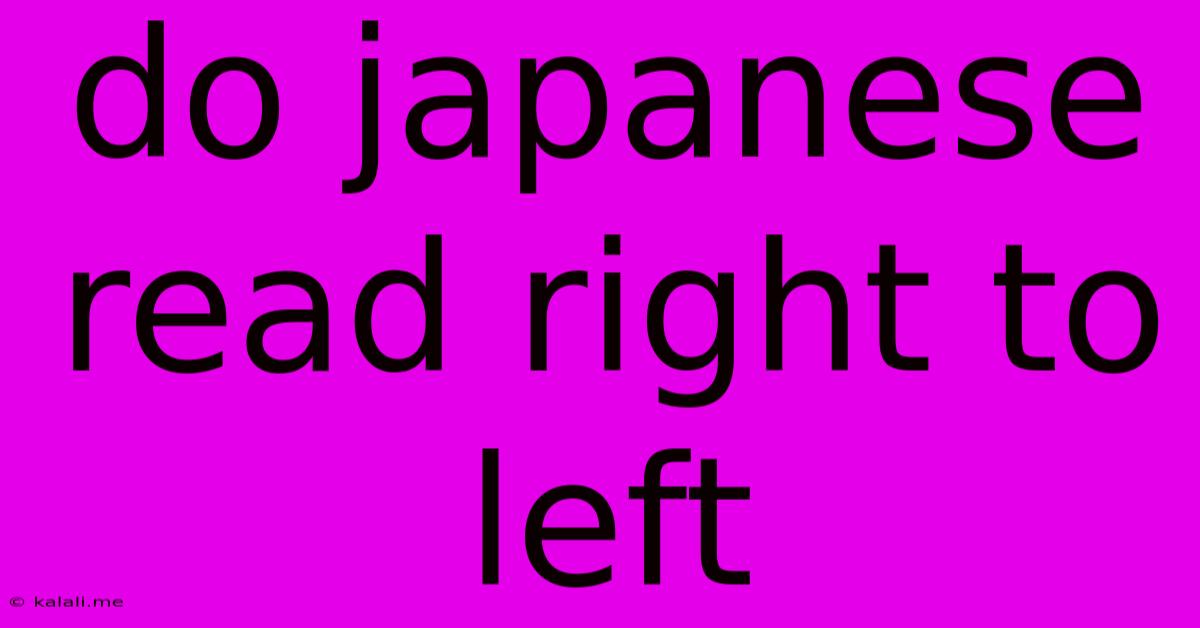Do Japanese Read Right To Left
Kalali
May 24, 2025 · 3 min read

Table of Contents
Do Japanese Read Right to Left? Unraveling the Mysteries of Japanese Reading Order
The question of whether Japanese is read right-to-left is a common one, often leading to initial confusion for those unfamiliar with the language. The short answer is: no, Japanese is not universally read right-to-left. The reading direction in Japanese is actually more nuanced and depends on the type of text. This article will delve into the intricacies of Japanese reading order, clarifying the common misconceptions and providing a clearer understanding. Understanding this is crucial for anyone looking to learn Japanese or engage with Japanese media.
Horizontal Reading: Left to Right, Top to Bottom
The most common way to read Japanese text is horizontally, from left to right, and then down to the next line. This is similar to the reading order used in English and many other Western languages. This applies to most modern Japanese text, including:
- Books: Novels, manga (although manga panels are read in a specific order within the page), and textbooks largely follow this left-to-right, top-to-bottom pattern.
- Newspapers and Magazines: Publications predominantly use the standard horizontal left-to-right reading order.
- Websites and Online Content: The vast majority of online Japanese content adopts the left-to-right format.
- Signs and Public Notices: These typically follow the standard horizontal reading direction for ease of understanding.
Vertical Reading: Top to Bottom, Right to Left (Traditional)
While horizontal reading is the dominant style, it's crucial to understand that traditional Japanese texts were written vertically, from top to bottom and right to left. This older style is still encountered in some contexts:
- Traditional Books and Documents: Older literature, historical documents, and some traditional forms of writing will use this vertical, right-to-left approach.
- Some Signage: Although less common now, you may still find vertical, right-to-left text on certain traditional signs or in specific settings.
- Calligraphy: Calligraphic works often maintain the vertical, right-to-left orientation.
Understanding the Shift: Modernization and Western Influence
The shift from vertical, right-to-left reading to horizontal, left-to-right reading is largely attributed to the influence of Western languages and the process of modernization in Japan. The adoption of the horizontal format has made Japanese text more accessible to a wider audience and is now the standard for most everyday communication.
Implications for Learners
For those learning Japanese, mastering both horizontal and vertical reading orientations can enhance comprehension and appreciation of the rich history and diverse applications of the language. Being aware of this subtle but important difference will help in successfully navigating various forms of Japanese text, avoiding confusion, and ensuring accurate understanding. Practicing with both styles will ensure a well-rounded understanding of Japanese text.
In Conclusion
While the misconception persists that Japanese is read right to left, the reality is more complex. While traditional Japanese text employed a vertical, right-to-left orientation, modern Japanese predominantly utilizes a horizontal, left-to-right reading order, similar to English and many other Western languages. Understanding this distinction is vital for anyone learning or engaging with the Japanese language.
Latest Posts
Latest Posts
-
How To Say United States Of America In Spanish
May 24, 2025
-
Who Is The Angel Of Music
May 24, 2025
-
Error Stat Of Oracle Sqlnet Log Failed Permission Denied
May 24, 2025
-
Map Of Middle Earth Frodos Journey
May 24, 2025
-
Bright Colors Losing Detail Gimp Coloraize
May 24, 2025
Related Post
Thank you for visiting our website which covers about Do Japanese Read Right To Left . We hope the information provided has been useful to you. Feel free to contact us if you have any questions or need further assistance. See you next time and don't miss to bookmark.